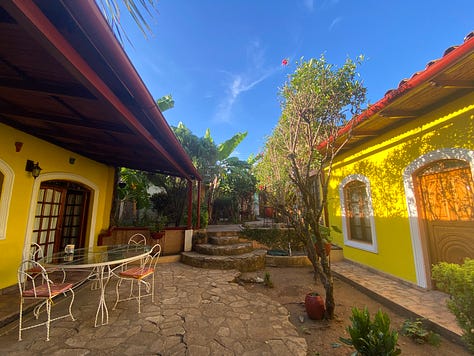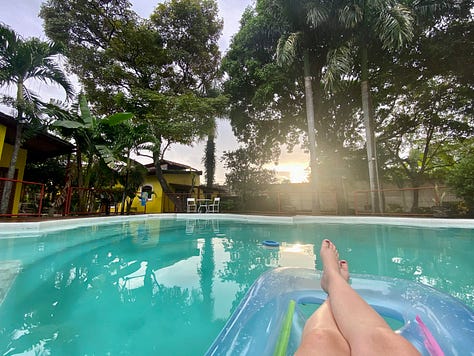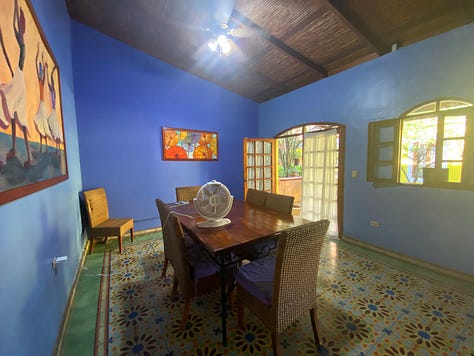The Case for Coliving: Because We're Not Meant to Do This All Alone, All the Time
In a world that worships independence, a few weeks in shared spaces reminded me of the quiet power of interdependence and why we might need more of it. Plus: this week's recommended reads.
✈️ Welcome to Midlife Nomads, your weekly hit of real talk, smart ideas, and helpful tools for building a location-independent life through remote work, travel, and business.
I spent most of my time in Scotland based in Edinburgh, and while the city itself is everything you'd hope — cobbled lanes, winding closes, old stone rising against misty skies — what really stood out this time wasn’t a particular castle or a café. It was the coliving space I stayed in.
It reminded me how deeply most of us are craving community. Not the performative, events-based, overly curated kind. Just… presence. Availability. The simple warmth of people in proximity.
We’re Not Meant to Do This Alone
In North America, we’re experts at designing for separation. One person, one box (for families, many people in individual boxes inside a larger box). We spend fortunes building homes we hardly see each other in, and then wonder why we feel disconnected.
Here in Canada, we’re facing a housing crisis that’s hitting older adults especially hard. Single senior citizens are increasingly isolated, financially stretched, logistically stuck, and emotionally sidelined.
And while not everyone wants roommates or a shared house, what we lack are options. Purpose-built spaces that allow for independence and connection. Somewhere between the lone condo and the institutional retirement home, there’s room for something better.
Recommended reading - The Pros & Cons of Nomad Houses: Coliving Conversations
What I experienced in Edinburgh wasn’t revolutionary, but it was restorative and I realized how much I’d missed that vibe. It’s that balance between autonomy and companionship that feels rare and deeply right, but it doesn’t just happen. You have to either find it or get out there and create it.
What made it really work was the intention behind the design. This wasn’t a house with multiple tenants; it was a space inside a historic building that had been completely redesigned and built for both privacy and connection.
A private sleep pod gave me the solitude I needed to recharge, while shared common areas were thoughtfully laid out, comfortable, and inviting. Good lighting, cozy nooks, communal tables… these little details add up to a space that supports both productivity and belonging.



Coliving can also look like private bedrooms with ensuite washrooms, separate houses with shared common areas and amenities, or even shared services like a driver, cook, and cleaners. The point is that they’re intentionally designed or reconfigured so you can retreat when you need solitude, and step out for company when you don’t.
And the company in Scotland was good. We had trivia nights. A casual creator’s meetup where we sketched and painted together. Interesting and impromptu coffee-fueled conversations. You know that feeling when a chat around the table stretches out, and suddenly hours have passed, and it feels meaningful even if you can’t quite explain why? That.
Successful Coliving Calls for Smart Design & Mutual Respect
Too often, shared living in North America feels like an afterthought. It’s cramped, makeshift, or institutional, because let’s be honest — shared living is seen as a downgrade in Canada and the USA. It’s where you go when you cannot afford to “make it on your own.” It’s a perceived failing, and that mindset sucks.



There’s a stereotype around coliving as either hostels or communes, and fair enough… those are two shapes it can take. But we’re not talking about party hostels here. It’s not about forced socializing or chaotic shared spaces. And I 100% agree: there’s nothing worse than having to clean someone else’s mess before you can make your morning coffee.
Coliving only works with healthy helpings of mutual respect. The magic happens when everyone shows up with a basic commitment to community care; washing up after themselves, keeping noise reasonable, reading the room.
In a well-run coliving setup, respect isn’t a house rule taped to the fridge. It’s part of the culture. And when that culture is in place, the space becomes more than functional. It becomes livable, whether for a month or for many years. When it’s done right, coliving becomes a lifestyle that respects autonomy and encourages genuine community.
Related:
As much as we value independence, there’s a quiet power in that interdependence… in knowing there’s a seat at the table, a pot of coffee on, and someone who’s glad to see you come around the corner.
This week’s reads circle around that same quiet truth: we’re not meant to go it alone; not in how we live, not in how we work.
Whether it’s through designing better communities, building healthier work rhythms, or finding new ways to show up (and be seen), these pieces all speak to the deeper threads of connection that make this lifestyle sustainable and meaningful.
On that note, here’s what I’ve been reading and thinking about:
A Month in Sicily, by Mary Bartnikowski
I’m headed to Italy this fall but Sicily isn’t on my list… not this time, anyway. But it’s definitely intriguing and on the “Sigh, Some Day” list. This dreamy travel tale of one woman’s month-long adventure in Siracusa, a UNESCO World Heritage site, will give you all the reasons, too.
👉 Read Seductive Siracusa Sicily by Mary Bartnikowski
Let Go of the Noise & Find Your Own Rhythm
This powerful essay from Brian Clark riffs on Beethoven’s Ninth Symphony as a metaphor for midlife reinvention. Drawing on Arthur Brooks’ insight that Beethoven’s deafness may have freed him from the noise of societal expectations, Clark challenges us to do the same: to tune out the old soundtrack of status and achievement, and instead create our own definition of success. A moving read for anyone standing at the edge of a new chapter.
👉 Read Are You Dancing to Society’s Soundtrack? by Brian Clark on Further
Nepal Will Soon Offer a 5-Year Nomad Visa
Nepal plans to go big with its first digital nomad visa offering and will reportedly offer the one-time multiple entry visa for up to five years. To qualify, you’ll need a monthly income of more than $1,500 or bank balance of $20,000"+, plus at least $100,000 in health insurance. Government officials there say they plan to launch the program within a year.
👉 Read Nepal eyes tourism, economic boost with new digital nomad visa policy on MSN.com
ICYMI: A Challenge to Take a Step Closer to Remote Income
My latest ‘One Step Closer’ column is for those of you contemplating traveling more or even going nomad for a few years (or longer), but doubting your ability to afford it. You don’t have to take your whole career as you’ve known it to this point on the road. Here’s where to start.
👉 Read One Step Closer: Get Ready to Go Remote Without Quitting Everything
That’s it for this week… safe travels!
✌🏻 Miranda
P.S. In case you missed it:







